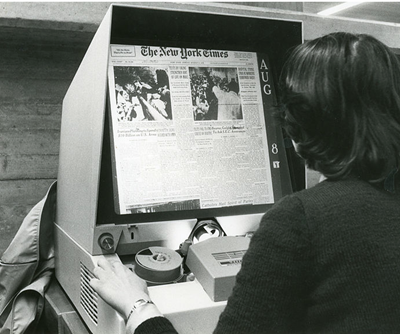eDiscovery Daily Blog
eDiscovery Throwback Thursdays – How Things Evolved

So far in this blog series, we’ve taken a look at the ‘litigation support culture’ circa1980, and we’ve covered how databases were built and used. We’ve come a long way since then, and in the next posts I’m going to talk a bit about how things evolved. But first, if you missed the earlier posts in this series, they can be found here, here, here, here, here, here, here, here and here.
Litigators who used databases circa 1980 – for the most part – recognized a significant improvement in efficiencies. As technology and approaches evolved over time, more efficiencies were realized.
One of the first big changes in how we worked was the use of microfilm. Paper documents were still photocopied and coded, but microfilm became the preferred mechanism for storing and retrieving documents. While the technology had been around for quite a long time, the litigation projects I worked on used paper repositories up until the early 1980s, which is when microfilm started to become the standard. This approach offered multiple advantages, the most significant being:
- It dramatically reduced the amount of space required to store a document collection. The documents for a large case could be stored in a box or two rather than in a room or two. This also meant that it was reasonable to have multiple copies of a document collection stored in offices convenient for the litigation team, rather than a single, central repository of documents.
- Attorneys still used central repositories to handle large document pulls, but with microfilm It was faster and easier to retrieve those documents — turnaround time was much better.
- It preserved the integrity of the document collection. Once a collection was filmed, pages wouldn’t be lost, shuffled, or damaged.
So, what is microfilm and how does it work? Micro-reproductions of document pages are stored on reels of film. Here’s a picture:

Those reels are labeled with the inclusive document number range. Now — when doing a document pull – instead of locating a box and pulling a document to photocopy, you would locate a reel, thread it on a microfilm reader (see picture above), scroll to the correct frame, and hit a print button.
This approach evolved even further, and we started using microfiche. The principle was the same, but the film was stored on cards instead of reels:

The cards were stored in sleeves labeled with the inclusive document numbers, and the cards were inserted into a microfiche reader.
Let me point out that microfilm and microfiche are still in use today in many libraries around the country. Most libraries are no longer ‘filming’ new documents (they’re using imaging technology), but many still have historic collections of newspaper and magazine articles stored on microfilm or microfiche.
Tune in next week — we’ll continue discussion of how the litigation world circa 1980 evolved and got to where it is today.
Please let us know if there are eDiscovery topics you’d like to see us cover in eDiscoveryDaily.
Disclaimer: The views represented herein are exclusively the views of the author, and do not necessarily represent the views held by CloudNine Discovery. eDiscoveryDaily is made available by CloudNine Discovery solely for educational purposes to provide general information about general eDiscovery principles and not to provide specific legal advice applicable to any particular circumstance. eDiscoveryDaily should not be used as a substitute for competent legal advice from a lawyer you have retained and who has agreed to represent you.
